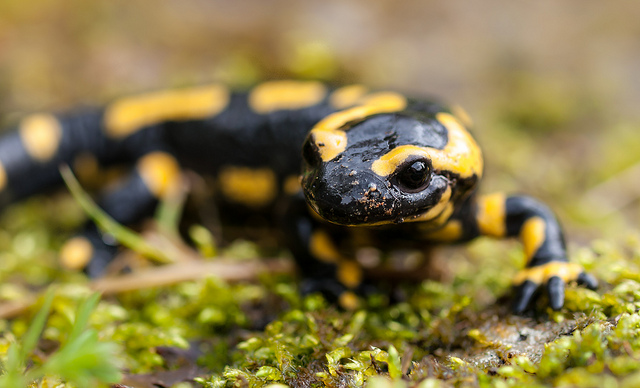 Microbiology
Microbiology
How a fungus causes the collapse of salamander populations
Fire salamanders in Europe are threatened by a seemingly relentless pathogen. How will salamanders cope with this aggressive fungus?

The fungal skin disease "Chytridiomycosis" is an important cause for amphibian diversity loss. This particular disease is emblematic for human mediated spread of pathogens from their native into new ranges, with the potential to extirpate the newly invaded host populations. The Asian chytrid fungus Batrachochytrium salamandrivorans (Bsal) is held responsible for this disease and it has been recently vectored into Europe. There it is currently causing population crashes in fire salamanders. These crashes result in a loss of over 90% of a population in just sixth months' time, which makes a population vulnerable to extirpation. Understanding the mechanisms that underpin these processes is key to develop mitigation strategies. With our research, we unravelled the complex interaction between host, pathogen and environment that creates the perfect storm that is currently threatening the survival of salamanders in Europe.
Bsal is an aggressive fungus that quickly kills fire salamanders by destroying their skins. As soon as the disease makes its apparition in a salamander population, thanks to the high densities of individuals, the infection likely spreads mainly through direct contacts between animals. This happens for example during courtship and through severe contamination of the environment. More intense interactions between adult salamanders (mating, territorial issues) may explain why adult salamanders are infected at a higher proportion compared to younger individuals. This leads to a reduced reproductive capacity of the population, compromising compensation for the losses suffered.
However, one would expect the outbreak to stop once the salamander density has dropped below the level that is necessary for Bsal to find and colonize a new host. Unfortunately, this does not happen and the decline continues until extirpation of the population becomes likely. There might be two different explanations for that:
The first one is the presence of an infective reservoir (a sort of protected hideout) where Bsal persists and from which it can spill over to the few uninfected fire salamanders that are still around. Other salamander, frog and toad species that are less susceptible to the disease but may be infected persistently constitute one part of this reservoir. Furthermore, Bsal produces spores that endure in the environment for long periods of time and thus create a highly infectious environment. The presence of these reservoirs allows BsaI to persist within the infected ecosystem.
A second explanation can be found in that Bsal remains highly virulent for fire salamanders even after continuous presence for at least two years in a susceptible population. This may seem strange, since extirpation of its host would cause Bsal to disappear as well, yet can be explained by maintenance of Bsal in its reservoir host population as mentioned above, from which it spills over to the fire salamanders. What remains a mystery is why selection for increased resistance in the remaining fire salamanders appears not to take place. Indeed, these animals did not show any ability to mount a protective response against Bsal, even after repeated vaccination.
In conclusion, this study depicts a grim image of how the encounter of a pathogen (Bsal) and a host (fire salamander) that are new to each other may end up in a destructive confrontation when all factors line up. It stresses the role of global trade in the spread of pathogens and their impact on biodiversity. Although the results of this study exclude several potential options for controlling the infection (e.g. eradication, vaccination), they provide important clues for designing mitigation measures that should counteract the impact of Bsal on Europe's salamanders. We stress the urgency of developing a pan European early warning system, imposing measures to reduce the probability of further entry and spread of amphibian pathogens and the design of emergency action plans.
Original Article:
Stegen G, Pasmans F, Schmidt B, Rouffaer L, Van Praet S, Schaub M, Canessa S, Laudelout A, Kinet T, Adriaensen C, Haesebrouck F, Bert W, Bossuyt F, Martel A. Drivers of salamander extirpation mediated by Batrachochytrium salamandrivorans. Nature. 2017;544(7650):353-356. doi:10.1038/nature22059.Next read: Tara Oceans Expedition sequences the ocean by Chris Bowler
Edited by:
Massimo Caine , Founder and Director
We thought you might like
Driving down malaria
Jul 18, 2017 in Health & Physiology | 4 min read by Andrew Hammond , Xenia Karlsson , Ziyin WangTuberculosis drug discovery: an in-house toxin blocks pathogenic bacterial growth
Feb 26, 2021 in Microbiology | 3 min read by Yiming Cai , Ben UsherNew treatment options for Zika virus infection
Jun 2, 2021 in Health & Physiology | 3.5 min read by Rachel P. M. Abrams , Avindra NathWhy some forests burn better than others
May 19, 2015 in Earth & Space | 4 min read by Elisa Dell'AglioMore from Microbiology
Monoclonal antibodies that are effective against all COVID-19 -related viruses
Jan 31, 2024 in Microbiology | 3.5 min read by Wan Ni ChiaPlagued for millennia: The complex transmission and ecology of prehistoric Yersinia pestis
Jul 31, 2023 in Microbiology | 3 min read by Aida Andrades Valtueña , Gunnar U. Neumann , Alexander HerbigHow cellular transport can be explained with a flip book
Jun 5, 2023 in Microbiology | 3 min read by Christina ElsnerThe Achilles’ heel of superbugs that survive salty dry conditions
Apr 24, 2023 in Microbiology | 4 min read by Heng Keat TamNew chemistry in unusual bacteria displays drug-like activity
Mar 21, 2023 in Microbiology | 3.5 min read by Grace Dekoker , Joshua BlodgettEditor's picks
Trending now
Popular topics


